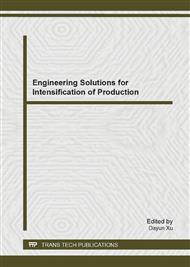[1]
Pérez, R. 2002, Characterization and representation of functional requirements and tolerances in conceptual design: contributions for implementation in CAD systems (in Spanish), Ph.D. Thesis, Mechanical Engineering, Barcelona Tech, Spain.
Google Scholar
[2]
Pérez, R., Ciurana, J. & Riba, C. 2006. The characterization and specification of functional requirements and geometrical tolerances in design. Journal of Engineering Design, 17(4): 311-324.
DOI: 10.1080/09544820500275263
Google Scholar
[3]
Björke, O. 1978. Computer-Aided Tolerancing, ASME Press, 2nd edition. New York.
Google Scholar
[4]
Kimura, F. 1996. Architecture of Intelligent CAD System. In Yoshikawa, H. y Gossard, D. (Eds. ), Intelligent CAD, Amsterdam, Holland, 29-33.
Google Scholar
[5]
Pérez R., Ciurana, J., Riba, C., Molina, A., Romero, D., Hernández, L.W. & Quesada, A.M. 2011. Concurrent Conceptual Evaluation of Tolerances Synthesis in Mechanical Design. Concurrent Engineering: Research and Applications, 19(2): 175-186.
DOI: 10.1177/1063293x11406147
Google Scholar
[6]
Juster, N.P., Modeling and Representation of Dimensions and Tolerances: A Survey, Computer Aided Design, Vol. 24 (1). 3-17.
Google Scholar
[7]
Ciurana, J., Riba, C. & G. -Romeu, M.L. 2004. Computer aided system for unidirectional functional dimensioning and tolerancing synthesis. Engineering Computations. 21, 455–469.
DOI: 10.1108/02644400410543913
Google Scholar
[8]
Requicha, A.A.G. 1983. Towards a theory of geometric tolerancing. International Journal of Robotic Research. 2(4), 45–60.
Google Scholar
[9]
Anselmetti, B. and H. Louati. Generation of manufacturing tolerancing with ISO standards. International Journal of Machine Tools & Manufacture, 45(10): 1124-1131, (2005).
DOI: 10.1016/j.ijmachtools.2005.01.001
Google Scholar
[10]
Franciosa, P., Patalano, S. &Riviere, A. 2010. 3D tolerance specification: an approach for the analysis of the global consistency based on graphs, International Journal of Interactive Design and Manufacturing. Vol. 4, 1-10.
DOI: 10.1007/s12008-009-0067-7
Google Scholar
[11]
Whitney, D.E.: Mechanical Assemblies, Their Design, Manufacture, and Role in Product Development. Oxford University Press, New York (2004). ISBN 0-19-515782-6.
Google Scholar
[12]
Cao, Y., Zhang, H., Mao, J., Xu, X. & Yang, J. Study on tolerance modeling of complex surface. International Journal of Advanced Manufacturing Technology. Vol. 53. 1183-1188.
DOI: 10.1007/s00170-010-2892-z
Google Scholar
[13]
Liu, W., Liu, J., Ning, R. & Jiang, K. 2011. Unified dimension and tolerance modeling for mechanical precision predicting. International Journal of Advanced Manufacturing Technology. Vol. 57. 307-232.
DOI: 10.1007/s00170-011-3275-9
Google Scholar
[14]
Chen, X., Gao, S., Guo, S. & Bai, J. 2012. A flexible assembly retrieval approach for model reuse. Computer-Aided Design. 44, 554-574.
DOI: 10.1016/j.cad.2012.02.001
Google Scholar
[15]
Zhang, Y., Li, Z., Gao, J., Hong, J., Villeco, F. & Li, Y. 2012. A Method for Designing Assembly Tolerance Networks of Mechanical Assemblies. Mathematical Problems in Engineering. Vol. 2012, 1-26.
DOI: 10.1155/2012/513958
Google Scholar
[16]
Avila-Rondón, R.L., et. al. CAPP based on form features. 13th ISPE/IEE International Conference on CAD/CAM Robotics & Factories of the Future'97. Pereira. Colombia. Nov. (1997).
Google Scholar
[17]
Rodríguez Hernández, O., et. al. Applied Drawing Practical Manual (In Spanish). CUJAE. Cuba. 1982. 333 p.
Google Scholar


